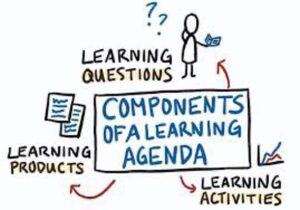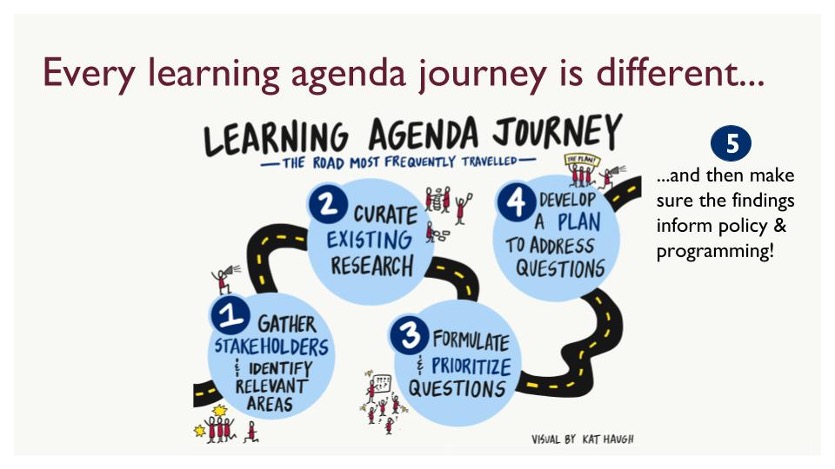My name is Laura Adams and I am a learning agenda fanatic (as well as the Co-Chair of the DRG TIG this year), so I’m happy to be introducing the DRG week blogs, all of which touch on learning agendas. “Learning agendas” have become ubiquitous across United States Government (USG) agencies over the last five years following the passage of the Evidence Act in 2018 and are now required as a type of systematic plan for identifying and addressing important questions to inform decision-making based on project evaluations. Our blog posts this week focuses on NGOs and also examines the slippery concept of “capacity building” in the DRG sector and will share some exciting updates from colleagues who have been part of the Made in Africa Evaluation project.
I first heard about learning agendas when I left my career as an academic sociologist to bridge the gap between academia and practice by joining the learning team in the DRG Center at USAID. We worked on the DRG Center’s 2016-17 learning agenda. When I asked my successor, Matt Baker, for his reflections on what has changed between 2016 and the current learning agenda, he said, “in recent years, learning agendas have evolved from a cutting edge practice to being integrated as a daily habit. …This [evolution] has included aiming to do a more targeted set of learning questions and also focusing on process type questions that focus on improving how we support dissemination and uptake of evidence and learning.”

What is a learning agenda? A learning agenda is a set of questions that require evidence to answer and that are intended to be used for designing more effective interventions (in this case, by international development practitioners).
What are learning agendas for? As the examples in some of this week’s blog posts will show, learning agendas can be used for a variety of purposes such as refining theories of change (Mundt); advancing a strategy for organizational change (Connolly); and to document and analyze patterns across diverse interventions (Kohlberg-Shah).
Lessons Learned
The authors of this week’s posts agree that a good learning agenda allows us to:
- Focus our resources on a few particular areas of use to the practitioners we work with, dividing questions up into manageable buckets;
- Synthesize existing evidence from academic research and translate its practical applications;
- Build use of the findings into an action plan that encourages uptake in future interventions (such as through MEL tools built on the findings).
In my current practice at Pact as MERL Director for CSM-STAND, I always attach a learning agenda question to its own budgeted action plan that includes both data collection/analysis and use/uptake. Finally, involving your end-users from the beginning to design the agenda is one of the best practices all the authors have used. An evaluation of the 2016-17 DRG Center learning agenda found that the learning agenda process had promoted a culture of reflection and deliberation in the Center and that a participatory approach at each stage had led to a sense of ownership of the findings by the technical experts who could best use them.

Rad Resource
USAID’s guidance on establishing a learning agenda
This week’s DRG TIG week blog series also features posts about the ways that members of the African Evaluation Association (AfrEA, our sister organization) have been Africanizing evaluation practice through the Made in Africa Evaluation project, including understanding and indigenizing MEL concepts and principles through Swahili proverbs (Mwaijande) and the African Evaluation Principles, which are “rooted in and tailored for African contexts, needs and knowledge systems, yet informed by international insights, theories and good practices” (Nayenga). Last but not least, Jeanette Tocol will share some insights into how to evaluate capacity building activities by taking broader impact into account.
The American Evaluation Association is hosting Democracy, Human Rights & Governance TIG Week with our colleagues in the Democracy, Human Rights & Governance Topical Interest Group. The contributions all this week to aea365 come from our DRG TIG members. Do you have questions, concerns, kudos, or content to extend this aea365 contribution? Please add them in the comments section for this post on the aea365 webpage so that we may enrich our community of practice. Would you like to submit an aea365 Tip? Please send a note of interest to aea365@eval.org. aea365 is sponsored by the American Evaluation Association and provides a Tip-a-Day by and for evaluators. The views and opinions expressed on the AEA365 blog are solely those of the original authors and other contributors. These views and opinions do not necessarily represent those of the American Evaluation Association, and/or any/all contributors to this site.
